The Office of the First Lady
The Important Role of First Lady as
Presidential Partner and her Office as Political Institution
Short History : Title
- The president wife had many titles until the present term “The First Lady”.
- Martha Washington, the first presidential spouse was called Lady Washington.
- Other titles: Lady Presidentress, President's Lady, even Queen or simply Mrs.
- The first official mention of the term ”First Lady” was by President Zachary Taylor during his eulogy for Dolley Madison when he referred to her as “our First Lady of the Land for a half a century”.
Role and Importance
- Scholarly research of the First Ladies is at this time still limited. Most of the research done focus on the period after 1930’s, starting with Eleanor Roosevelt.
- However, educated, active and famous First Ladies (President spouses) were noted by history, well before. Ex. Abigail Adams, Dolley Madison, Helen Taft.
- Today’s role can be understood and valued only by studying the contribution of all previous ladies.
- The role and importance of the First Lady as a concept and the Office of the First Lady as an institution residing in the White House, is the result of the work of the presidential spouses through out our entire history.
- Martha Washington, the “First” First Lady did not have a model of how to be a First Lady.
- It is an unique history documented by letters , diaries, and other papers written by First Ladies during their stay in the White House.
- According with Robert P. Watson in his article “The First Lady Reconsidered: Presidential Partner and Political Institution” Presidential Studies Quarterly, Fall 1997, V. 27, Nr. 4, pp. 805-818, there are a number of historical periods that lead to the current status of the Office of the First Lady.
Development of the Institution of the First Lady
- 1789-1817 First spouses shaping the image and role: Martha Washington, Abigail Adams, Dolley Madison.
- 1817-1869 Absent spouses, affected by illness and death: Hannah Van Buren, Abigail Fillmore, Eliza Johnson.
- 1869-1909 Transitional spouses: unfulfilled possibilities: Lucy Hayes activism limited by her husband, Lucretia Garfield limited by poor health.
- 1909-1945 Aspiring Spouses: Developing New Roles: Helen Taft, Lou Hoover, Eleanor Roosevelt
- 1945-1974 Supportive spouses: Model Wives in the Public Era: Bess Truman, Mamie Eisenhower, Jackie Kennedy, Lady Bird Johnson, Pat Nixon.
- This was a period of less assertive First Ladies. For different reasons they kept a low profile vis-à-vis their husbands in comparison with the more active roles played by their predecessors.
- 1974- present Modern Spouses: Public Presidential Partners: Elizabeth Ford, Rosalyn Carter, Nancy Reagan, Barbara Bush, Hilary Clinton.
- The more recent First Ladies are not yet categorized: Laura Bush, Michelle Obama, Melania Trump
- These First Ladies are our contemporaries and we know them from their times in office. They are active and public partners of the president, attend cabinet meetings, initiate and follow personal projects consistent with the line of their husbands’ presidency.
- Public Law 95-570 passed in 1978 grants authority to establish funds to manage W.H.
- In the annual budget for its operational funding that the executive branch requests Congress to appropriate, there is federal funding to salary the staff of a spouse of a president to allow them to "help the president to carry out the duties of the presidency."
- The First Lady's office is located in the East Wing of the White House. East Wing was build during Franklin Roosevelt’s presidency.
- First Ladies do not receive a salary for their service.
- Many of the presidents widows were wealthy enough to support themselves, but others were on the brink of poverty.
- Dolley Madison sold her late husband, President James Madison, papers and documents to the National Archives for $30,000
- Mary Todd Lincoln received a pension for life after much effort and support from friends, was awarded a pension of $5,000 annually on Feb. 2, 1882
- On March 31, 1882 Congressional action granted $5,000 for life for the presidential widows.
- In 1958 the Congress increased the pension to $20,000 per year for life for the presidential widows.
- An Act from Apr. 3, 1800 granted free lifetime mail services to presidential widows. This one still stands.
- The First Lady and family receive Secret Service protection in the W.H. and after.
Capacities in which First Lady Serves the President
- Social hostess and household manager
- White House renovator-preservationist
- Campaigner and spokesperson
- Advocacy and Social activism
- Active participation in the Policy process
- Presidential and political partner
- Presidential companion
- Presidential advisor and confidante
- Wife and mother
Advice to the First Lady from the Popular Press
- First Ladies have always been public figures and celebrities and perceived as a symbol of American woman. In this capacity they received all kinds of advice. Here it is a list from “Ladies Home Journal” by journalist Diana McLellan published January 1, 1993. It is kind of anecdotic, but with common sense and useful:
- As the nation’s top Hostess, don’t be stingy
- Include your family in White House celebrations
- Remember to have a social and private life
- Fulfill the role of wife by supporting and protecting the president
- As First Lady do not forget the women in Washington (have social functions for women)
- Expect criticism and get a very good Press Secretary
- Promote yourself and your accomplishments
- Practice making speeches
- Respect and give credit to the public
- Travel with and campaign for the president
- Assist the president with cabinet selections and staffing
- Be aware of president enemies
The future of the Office of the first Lady
- Mrs. Barbara Bush in a challenged graduation speech declared: “And who knows? Somewhere out in the audience may even be someone who will one day follow in my footsteps, and preside over the White House as the President’s spouse. I wish him well!”
- The future is open to exciting events.
- The title of First Lady might change maybe to First Spouse to reflect a new couple in the White House.
Helen (Nellie) Herron Taft
Jan. 2, 1861-May 22, 1943
First Lady: Mar. 4,1909 - Mach 4,1913
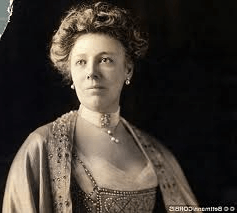
Helen Herron was born on Jan. 2, 1861 in the prosperous household of John Williamson Herron and Harriet Collins Herron, one of the 11 children in Cincinnati, Ohio. Politics and political conversations were part of Helen Herron life as she grew up.
In 1877 during a visit with her family as guests of President Rutherford Hayes and Lady Lucy Webb Hayes she developed a desire to be one day in the White House as a First Lady.
She took classes and studied between 1866 to 1879 at Miami University in Oxford, Ohio and University of Cincinnati, Ohio. After finishing studies she went on to teaching and organizing together with other two young women a salon for conversations on political and social issues of the day.
She met William Taft in 1879. He proposed on April 1885 and in June 1886 they got married at her parents house in Cincinnati.
White House Years
March 4,1909 - March 4,1913
Before the Presidency, the Tafts had an increasingly challenging and rewarding career in politics as William Taft took on: U. S. Solicitor General 1890, Governor General of Philippines 1902, T. Roosevelt’s Secretary of War 1902. In 1906 Helen Taft began to campaign for her husband’s nomination of the Republican Party. When she approached President Roosevelt for support he was not too pleased, commenting that she was more ambitious than her husband.
During the campaigning years she was a solid support for William Taft, writing and correcting speeches, following the press commentaries, giving advice.
- Inauguration day March 4, 1909 as the 27th President of U.S.
- Mrs. Helen Taft rides with the newly sworn-in President from the Capitol to the White House.
- First Lady Helen Taft will introduce new staff positions to make the W. H. more welcoming and better managed.
- Start plans to redesign the W.H. grounds and extend park landscape for public use.
- Organize lavish social affairs at the W.H.
- Attend most meetings and conferences with dignitaries, politicians and diplomats at the W.H.
- In May 1909 Mrs. Taft suffered a debilitating stroke. With her husband help, it took until 1911 for her to completely recover.
- First Lady Helen Taft had the ambition to create a beautiful public Park in the vicinity of W.H. She employed the help of the Department of Agriculture to collect planting materials to plant an area with cherry trees. Also some of the trees were send from Japan.
- The inauguration was in March 1912 with the First Lady and the Viscountess Chinda, wife of the Japanese Ambassador.
- To this day this is the biggest accomplishment of First Lady Helen Taft for which she is remembered every Spring at the blooming time.
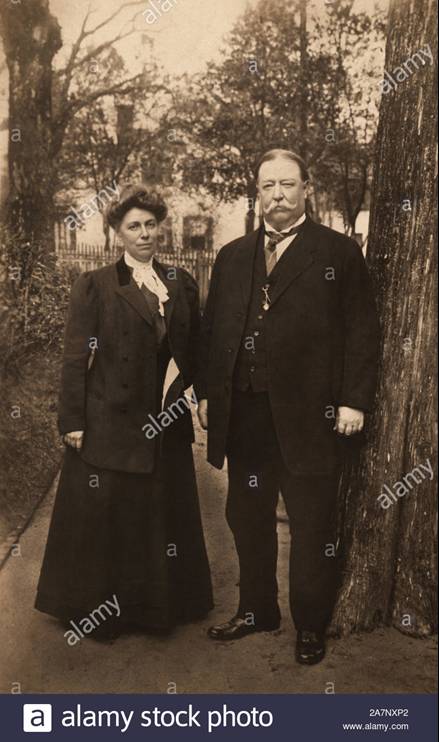
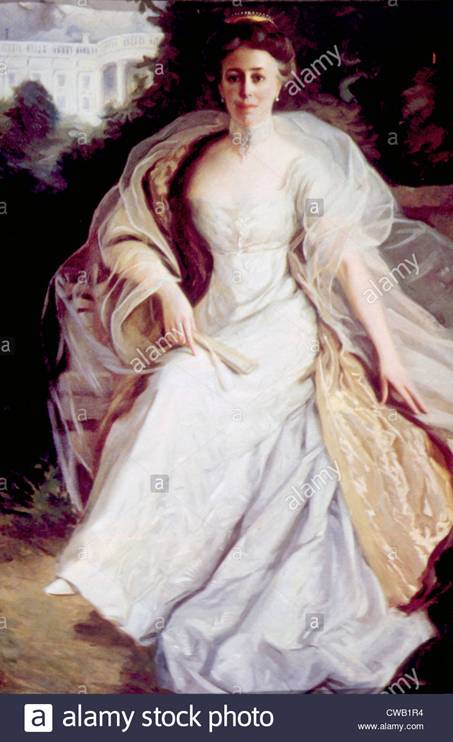
Nellie Taft was the first First Lady to:
- publish her memoirs (“Recollections of the Full Years”, 1914),
- own and drive a car,
- support women's suffrage,
- smoke cigarettes,
- successfully lobby for safety standards in federal workplaces.
- accompany her husband in the inauguration parade
- Nellie Taft was widowed upon the death of her husband on March 8, 1930. She continued to be socially involved serving as an honorary vice president of the
Colonial Dames of America and the
Girl Scouts of the USA. She died in
Washington, D.C. on May 22, 1943, and was buried next to the President at
Arlington National Cemetery.
Claudia Alta Taylor (Lady Bird) Johnson
Dec. 22, 1912 – July 11, 2007
First Lady: Nov. 22, 1963 – Jan. 20, 1969
Claudia (Lady Bird) Johnson was born in Karnack TX, on Dec. 22, 1912 to Thomas Jefferson Taylor and Minnie Patillo Taylor. The family was wealthy due to her father business skills. He owned 15,000 acres of cotton plantation and two general stores. Her mother was a cultured woman, reading classics to their children and going into trips to Chicago to attend opera productions.
Claudia’s (Lady Bird’s) mother passed away due to an accident when she was only 6 years old. She was raised by an aunt, a sister of her mother.
- Claudia Taylor graduated from Marshall High School and after a few years break went on to University of Texas at Austin and graduated with a major in history in 1933.
- In the summer of 1934 she met Lyndon B. Johnson, an aide to a member of Congress from Texas. They had a short and active courtship and married in San Antonio on Nov. 17, 1934.
- In 1937 with the financial help from his wife and father-in-law, Lyndon B. Johnson won the position of Congressman in the Tenth District in Central Texas.
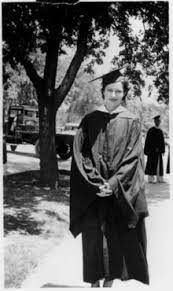
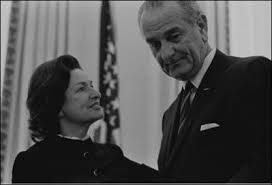
- Dec. 7, 1941 Pearl Harbor attack by Japanese. Earlier LBJ joined the Navy and in April 1942 went for an inspection tour to the South Pacific. During this time Lady Bird Johnson run his Congressional office in Washington.
- In 1943 worried about a political defeat in elections the Johnsons decided to improve their financial resources by investing in a Radio station in Austin. This endeavor turned into a multimillion media empire before LBJ election in 1963.
- In 1960 LBJ is elected on the JFK ticket as the VP of the 35th U.S. President.
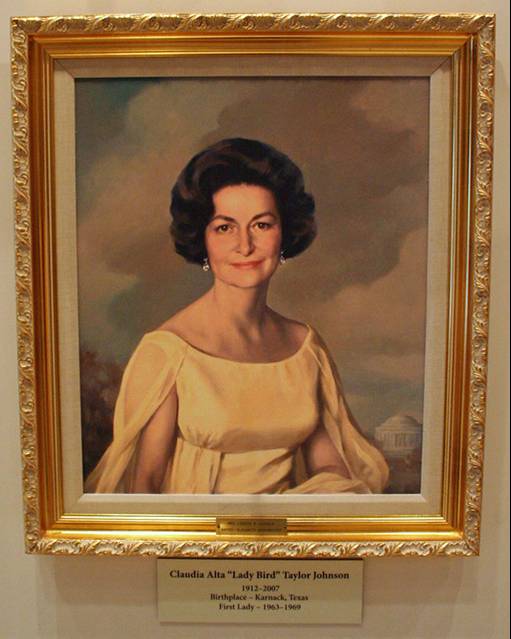
Claudia Alta Taylor (Lady Bird) Johnson
White House Years as First Lady
Nov. 22, 1963 – Jan. 20, 1969
First Lady, Lady Bird Johnson accomplishments:
- Invented the job of modern first lady.
- First activist president wife since Eleanor Roosevelt.
- first one to have a big W.H. office staff.
- first one to have a comprehensive program in her own name, The Beautification Act.
- important role in setting up an enduring role for her husband with the LBJ Library.
- first one to campaign extensively on her own for her husband.
- Lyndon B. Johnson died in 1973.
- After the W.H., Lady Bird Johnson still accomplished a number of important projects:
- Wrote a best-seller book “Wildflowers Across America” with Carlton Lees in 1988.
- Her interest and activism for the Environmental issues remained active to the end.
- The first woman to serve on National Geographic Society's Board of Trustees.
- National Wildflower Research Center in Austin TX, renamed the Lady Bird Johnson Wildflower Center in 1995
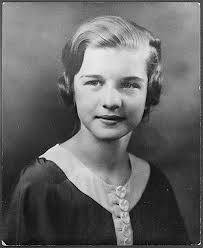
- In spring of 1942 Betty Bloomer married Bill Warren, whom she knew from her childhood. The marriage will last until 1947 and end in divorce.
- Same year she met Gerald Ford. Ford proposed in February 1948 and on Oct. 15 1948 they were married in the frenzy of his campaign for a seat in U.S. House of Representatives, representing the Fifth District in Michigan. The campaign was successful and they moved to Washington.
- The Washington years proved to be very demanding. Mrs. Ford was expected to assume duties of a congressional wife. Some of them were:
- Club Scout den mother; rooter of Little League games; Director of the Congressional Wives Prayer Group
- Sunday School teacher
- All these while Mr. Ford becomes in 1965 House Minority Leader.
- Dec. 6, 1973 in the White House, President Richard Nixon announced that he will take Gerald Ford as his new Vice President.
- On Aug. 8, 1974 President Nixon resigned. Gerald Ford was sworn-in the 38th President immediately in an emotional ceremony in the East Wing.
- Before a vacation in the same month, Mrs. Betty Ford, now the First Lady, went for a regular check-up. During the exam a lump was discovered in her right breast. She was scheduled for testing and surgery on Sept. 28. The lump was malign and she had radical surgery on her right breast.
- In the beginning the Fords decided to keep this information secret. While recovering in the hospital, First Lady Betty Ford, decided that will be beneficial to talk public about the importance of check-ups.
- She made public her experience with the illness, surgery solution and treatment, the reality of mastectomy, but most important the message was “go and have a check up, it will save your life”.
Elizabeth Ann (Betty) Bloomer Ford
April 8, 1918 – July 8, 2011
First Lady: Aug. 7, 1974 – Jan. 20, 1977
Elizabeth Ann Bloomer was born in Chicago on April 8, 1918, the last child and only daughter among three siblings. Her parents were William Stephenson Bloomer a conveyer-belt salesman and Hortense Neahr Bloomer.
The family settled in Grand Rapids, Michigan. With the father traveling often, the mother took charge of the household and raising the children.
To help with household expenses Betty was modeling children clothes for a department store in town. But her passion and interest was dance.
At the time she was sixteen, tragedy stuck, her father died in an accident.
Betty finished Central High School in 1936 and hoped to continue her dance education. She was accepted by Martha Graham as a student, and moved to New York City. She worked as a fashion model to finance her dance studies. She joined Graham's auxiliary troupe and performed with the company at Carnegie Hall.
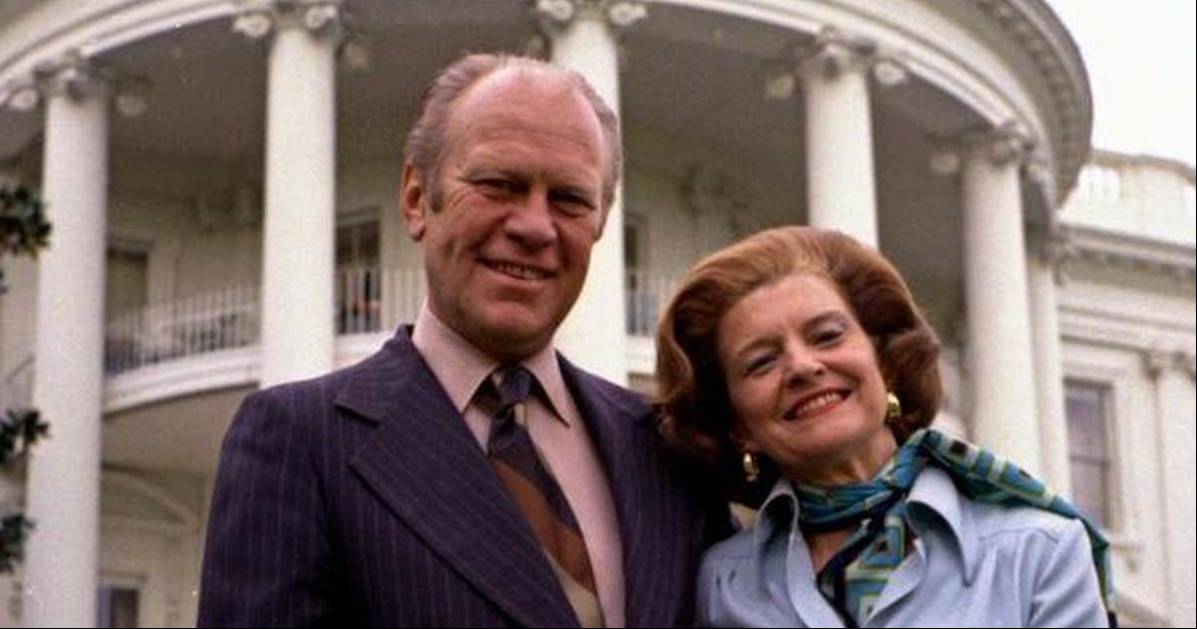
While in the W.H., First Lady Betty Ford, was an advocate and activist for a number of causes:
- Abortion rights
- Equal Rights Amendment (ERA)
- Appointment and election of more women in important government positions
- Awareness of mental illness
- Awareness of the danger of ignorance about breast cancer
- While her activism was not always approved by public, in 1975, “Time” magazine named Mrs. Ford one of its “Women of the year 1975”. None of the previous First Ladies received such an honor.
President Gerald Ford died Dec. 26, 2006.
- Following W. H. years, Betty Ford continued to lobby for the ERA and remained active in the feminist movement.
- Opened the talk about breast cancer, life saving check-ups and treatment.
- She was the founder of the Betty Ford Center for substance abuse and addiction.
- She was awarded the Congressional Gold Medal on October 21, 1998 and the Presidential Medal of Freedom in 1991 by George H. W. Bush.
Closing Remarks
While is impossible to predict the presence of the First Lady in the politics of the day, the Office of First Lady is a solid institution build throughout two centuries by previous First Ladies, women with all kind of education level, personalities, financial resources and personal charisma.
Credits and Bibliography
- Content: Elisabeth Anghel
- Illustrations: Mark Anghel
- Bibliography:
- “American First Ladies”, Lewis L. Gould, ed. 2001
- “America’s First Ladies”, Bill Adler, ed. 2002
- Watson, Robert P. “First Lady Reconsidered: presidential partner and political institution” Presidential Studies Quarterly Fall 1997, V.27, #4, p. 805-818
- Watson, Robert P. “The Presidents’ Wives: reassessing the office of the First Lady” 2000
- Wekkin, Gary D. “Role Constrains and First Ladies” Social Science Journal, 2000, V. 37, #4, p.601. 10p.